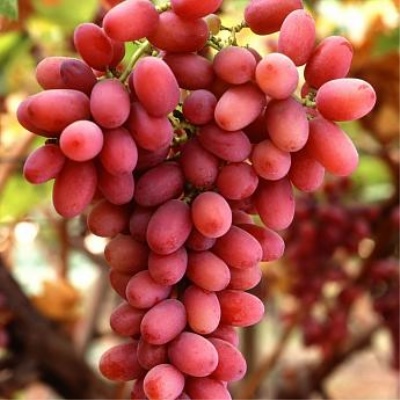
- Appointment: universal
- Berry color: smoky pink
- Taste: nutmeg, with kiwi flavor
- With bones: Yes
- Ripening period: early
- Ripening period, days: 115
- Frost resistance, ° C: -23
- Bunch weight, g: 150-200
- Density of the bunch: dense
- Landing scheme: 2-3 m between bushes
The Samokhvalovich variety is very widespread among gardeners. It is quite unpretentious to care for and has a high yield.
Breeding history
The Samokhvalovich variety was bred by the Chelyabinsk breeders of the Research Institute of POK.
Geography of distribution
This grape is a very thermophilic culture. It is grown in the southern regions. But despite the love of warmth, the plant is well adapted for growing in the Urals and Siberia, as well as in the northern regions.
Description
Vigorous grape bush with very good shoot development. 2-3 clusters are formed on each shoot.
Ripening period
Samokhvalovich belongs to varieties with an early ripening period. The growing season from the moment the buds bloom and until the fruits are fully ripe is 115 days.
Bunches
The bunch has a cylindro-conical or conical shape, the weight of one bunch is 150-200 g. The bunch is very dense.
Berries
The berries are smoky pink, medium in size, pitted, most often 1 per berry. The consistency of the pulp is very tender, crunchy, greenish-pink hue. The fruits have a universal purpose. They are used for making juices and homemade wines.
Taste
The taste is pleasant, nutmeg, with a pronounced kiwi aroma. The average weight of the berry is 4 g. The sugar content is 180 g / dm 3, the acidity is 4–5 g / dm 3.
Yield
The variety has a high yield. The fruits ripen at the end of August.


Growing features
Grape seedlings are recommended to be planted along walls or fences, from the south or south-east side. The landing site should be well lit by sunlight and protected from wind and drafts. Light nutritious chernozem or loam is best suited for the plant. It is better to plant seedlings in May or early June.
Landing
Before planting, the seedlings are processed by cutting the lower roots. The planting hole should be 80 to 100 cm deep. Before placing the seedling in the hole, sand and drainage in the form of sawdust or crushed stone are poured onto its bottom. Organic fertilizers and fertilizers based on superphosphate are also applied.
The distance between the seedlings should be at least 2-3 m. In order for the grapes to begin to curl, pegs are driven in between the bushes and a wire is pulled. A film is pulled over the wire arcs, thereby covering the seedlings. After planting the seedling, abundant watering of the root system is carried out.

Pollination
This variety is pollinated by the wind, since the flowers of the plant are bisexual.
Pruning
In order to avoid shading and peeling of berries, the obligatory normalization of the bush is carried out. Grapes do not need it for the first 2 years of growth. Pruning should be started in the fall, after the leaves have fallen off. In the spring, the frozen and dead after wintering shoots are cut off.

Watering
Regular watering of the grapes is an essential requirement for good vines development. The vineyard is watered at least 2-3 times a week. In drier weather, watering is increased and done once a day. The intensity of watering decreases with the growth of the bush, since excessive moisture can lead to the risk of freezing the bush, as well as to a decrease in the quality of the fruit. Watering should be stopped a week before flowering, as excess moisture can lead to shedding of flowers.


Top dressing
Fertilize grape bushes in spring and autumn. Adult plants during the flowering period must be sprayed from insects. It is better to do this in rainy and cloudy weather in the evening. Grapes love organic and mineral fertilizers: potassium, superphosphate, manure, compost, bird droppings.
Frost resistance and the need for shelter
Samokhvalovich grapes winters at a temperature of -23 ° C. Before you cover the vine for the winter, you must remove it from the supports. Then it is covered with straw or hay and covered with breathable material. For grapes, it is important that there is oxygen under the shelter, and moisture does not form, which can lead to rotting of the plant.

Diseases and pests
The grapes are quite resistant to diseases and pests. But sometimes the plant is still exposed to pests: phylloxera, grape leafworm and grape itch. To prevent the appearance of pests, it is necessary to spray the plant with special solutions. Dangerous diseases that can damage grapes are mildew and powdery mildew. You need to deal with them by spraying with a solution of Bordeaux liquid diluted with sulfur.

If a grape is exposed to any disease or insect, this always affects its appearance.
Storage
It is recommended to store grapes in well-ventilated places at a temperature not exceeding 10 ° C. The optimum humidity should be 95%. The bunches can be stored in boxes, not stacked very tightly and tightened each layer with foil.
Review overview
The grapes of this variety have a lot of positive ratings. According to the reviews of experienced gardeners, subject to the standard rules for caring for grapes, the plant will surely thank you with a generous harvest and an excellent taste of berries.











































































